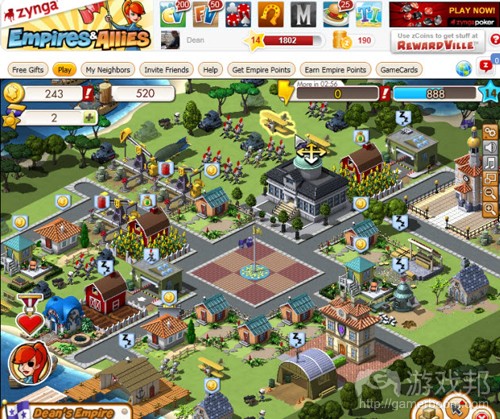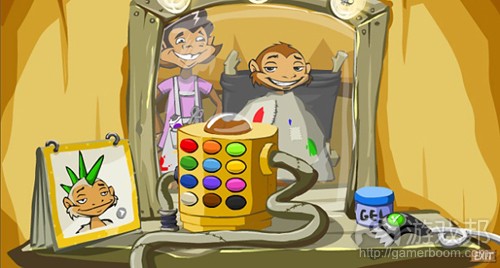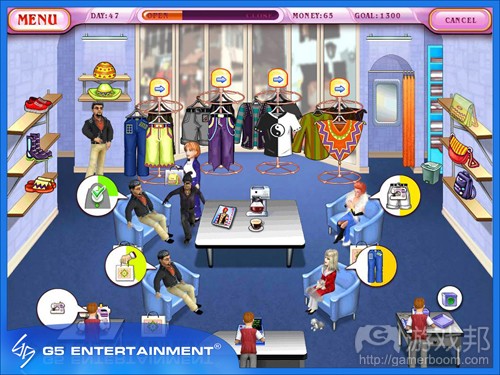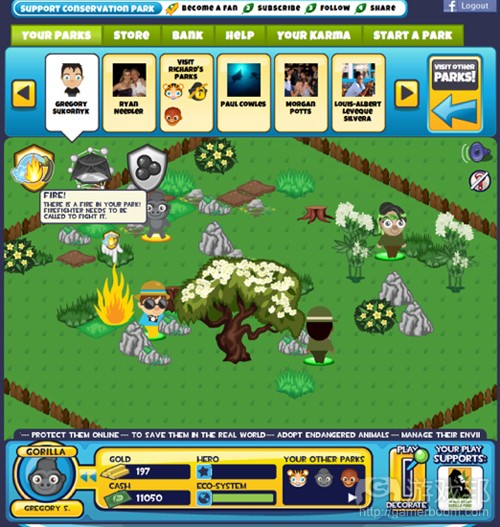每日观察:关注儿童社交网络盈利模式(6.20)
1)据AppData数据显示,Zynga新作《Empires & Allies》发布17天已收获3000万用户(游戏邦注:它在6月18日当天新增200万用户),Zynga游戏用户总数也已从原来的2.49亿,增长为目前的2.67亿。
2)据读写网报道,新西兰儿童虚拟世界MiniMonos上线仅6个月,当前用户已超过25万。该网站功能与迪士尼旗下的Club Penguin(月活跃用户超过600万)相似,为儿童用户提供了有趣的虚拟形象、游戏、虚拟商品等社交元素。MiniMonos不但支持儿童在游戏中与他人进行社交互动,而且还为他们在线下的废品分类回收等环保行动提供现实奖励,以寓教于乐的方式培养他们热爱自然,保护环境的意识。
3)美国互联网调查机构Pew Internet and American Life Project最近针对2255名用户的调查表明,比起其他非社交网络用户,Facebook用户之间的关系更为亲密,也更容易产生相互信任之感,更愿意彼此互助。社交网络并没有将人们与现实世界隔离,也并不曾影响人们在线下的社交联系。
调查指出,美国有79%的成年互联网用户,其中约有47%至少使用一个社交网站的服务;在这一群体中,有92%受访者是Facebok用户,29%是MySpace用户,还有18%使用Linkedin,13%使用Twitter。其中,Facebook和Twitter的用户粘性最高,有52%用户每天都登陆Facebook,每天访问Twitter的用户比例为33%。而每天都访问MySpace的用户仅7%,LinkedIn的同一比例也仅有6%。
有15%的Facebook用户每天都更新自己的状态,22%受访者会针对他人的贴子和状态留言,20%会对他人照片发表评论,26%会“赞”一下其他用户的内容,10%会向一个好友发送私聊信息。
Facebook活跃用户对他人的信任度比其他网络用户高43%,他们与好友关系的亲密度也比后者高9%,在对好友的情感支持上也高出5个百分点。在2008年,仅有29%用户称自己常与所有的“死党”坦露心扉,而如今的同一比例则高达40%。
4)诺基亚欧洲副总裁Victor Saeijs最近宣布,诺基亚制造的Windows Phone 7手机将于今年底首先在荷兰、法国、德国、英国、西班牙和意大利发布,但并未透露世界其他地区的发布日期。观察者称,诺基亚没有首先在北美推出WP7手机的重要原因之一是Android和iPhone已成当地市场智能手机的领军力量,诺基亚与这两者在北美的角逐并无胜算,只能采用曲线救国的方式找到突破口。
5)Nokia Beta Labs最近发布了一个增加可用性的新版Nokia Ovi Suite,这个3.1.1.40版本支持用户方便快捷地通过Ovi Suite主界面安装应用程序。假设用户的手机与电脑相连接,那么只需点击“下载并安装”就可以顺利实现这一操作。除此之外,这个新版本的Maps视图功能也得到改善,支持用户在同一时间下载多张地图,以便节省大量时间。
6)《Dress Up Rush》是一款由G5 Entertainment推出的时间管理类游戏,风格与《美女餐厅》相似,要求玩家在游戏中经营一家时装精品店,为源源不断的四方来客提供服务。游戏一共有60个关卡,设置了五个场景,玩家得向一系列穿衣风格和品味截然不同的顾客出售衣服。
但与传统的时间管理类游戏不同的是,《Dress Up Rush》中的顾客还会要求试穿衣服或佩戴饰品,而且还会要求玩家包装礼物。在他们坐在椅子上等待服务期间,玩家得奉上咖啡,他们转身离去时玩家还得尽快清洁被客人弄脏的位置,在每一名客人进门至出门的全过程中都要为其提供周到服务。
7)新兴社交游戏开发商Good World Games日前开发了一款专为公益事业造福的Facebook游戏《MyConservationPark》,支持用户通过游戏活动挽救濒危动物。该游戏含有体验(Play)和装饰(Decorate)两个模式,在前一个模式中,玩家需要成功克服多项挑战,以保护自己公园中的生态平衡;在第二个模式 ,玩家可以创造一个人类与动作和谐相处的天堂,并购买瞭望塔、公园管理员、稀有动物等虚拟商品装饰自己的公园。
该公司将把15%的虚拟商品收益捐赠给相应的动物保护组织,游戏中的每一个公园都有相应的公益合作机构,例如Dian Fossey Gorilla Fund、Sea Shepherd、Wildaid和Orangutan Outreach等。玩家还可以从中看到自己在游戏活动中的捐赠比例。游戏中的每一个公园都有不同的主题和挑战,在其中获得高分者还有机会赢得现实世界中的奖励——获得访问其中一个非盈利性组织的全程路费,并担任一定时间的动物保护志愿者。
Good World Games表示公司计划推出更多类似的社交游戏,让Facebook用户通过游戏对现实世界产生积极影响。
8)据adage报道,儿童社交网络是一个蓬勃发展的领域,吸引了不少投资者的目光,但却难以通过广告项目创造收益。Everloop最近刚融资310万美元,Togetherville也于今年初被迪士尼收购,成立已三年的Moshi Monsters也在今年吸金1亿美元,但却没有分毫收益来自广告商。
Moshi Monsters的社区安全管理员Rebecca Newton表示,他们其实经常收到企业广告主伸出的橄榄枝,但儿童用户很难理解虚拟商品与真实商品之间的关联,以及大众认为广告会对儿童产生消极影响的看法,不得不让他们小心行事,不敢轻易试水广告赞助领域。
Togetherville等公司还认为,他们的社交网络若要通过广告赞助创造收益,还将面临与Facebook一样的难题。Facebook的广告策略就是,用户如果“赞”过某广告,该广告就会显示用户的姓名和照片。而公众显然很反对Facebook在社交广告中利用孩子的图片等资料。最近的消费者报告指出,尽管Facebook不支持13岁以下的用户访问其网站,但在美国仍有750万的Facebook用户年龄不足13岁,此外还有1440万年龄介于13至17岁的Facebook用户,Facebook根本无法控制儿童用户隐瞒真实年龄注册Facebook帐号的情况。
Moshi称他们决定通过推出毛绒玩具、雕像工艺品等线下产品打造品牌,公司有2亿多美元收益来自线下玩具、集换卡片和杂志等周边产品。除此之外,该公司的另一营收来源是每月每人的8美元会员费用(仅限升级到付费会员的用户),及其虚拟货币Rox。
Togetherville公司的做法与此有所区别,他们不接受任何广告赞助或订阅模式,而主要通过T-bill这种让家长付费支持孩子玩游戏、购买商品的虚拟货币创造收益。
而Everloop却另有主张,他们并不完全避开广告品牌,而是通过让孩子与品牌进行互动,提高品牌曝光率,但并不向孩子推销产品的方式盈利。该公司CEO及创始人Hilary DeCesare表示,孩子们每天都要面对在线广告,Everloop的目标就是让他们找到自己感兴趣的产品。例如,发行商Simon & Schuster就针对《Dork Diaries: Tales from a Not-So-Fabulous Life》这本著名的儿童读物在Everloop展开推广活动,虽然孩子们未必知道这家发行商的名称,但多数人对这本书都不会感到陌生,这类广告项目有助于为孩子创造交流话题,让他们与好友谈论这本读物。(本文为游戏邦/gamerboom.com编译,如需转载请联系:游戏邦)
1)Zynga’s Empires & Allies social game has grown to more than 30 million users in just 17 days. The combat social strategy game added about 2 million users today, according to market analyst AppData.
This kind of rapid growth is becoming normal for every new Zynga game launch. That’s going to make it easier for Zynga to go public, if it actually files for an initial public offering, as rumored. Public markets like predictable performance, and Zynga can churn out the hits because it uses its older games to promote its new ones. The company has become a Facebook distribution powerhouse. That makes it a lot easier for Zynga to generate revenue, since a percentage of users usually pays for items in otherwise free games.(source:venturebeat)
2)MiniMonos: Linking Kids’ Virtual World and Real World Actions
By Audrey Watters
With a number of news stories lately about kids under 13 on Facebook ( on the site against the social network’s terms of service), you’d think there weren’t any other social networking sites that were geared for kids or where kids wanted to be. That’s hardly the case, as there are many social networks, gaming sites, and virtual worlds aimed at the under 13 set. In fact, a study last year suggested that of the billion some-odd users of virtual worlds, over half are under age 15.
One of the newest kid-friendly sites is MiniMonos, a New Zealand-based company that, just six months after its launch, already has over 250,000 users. That’s dwarfed, of course, by the popular Disney-owned Club Penguin, with over 6 million monthly active users. And while MiniMonos is similar to Club Penguin and other virtual sites with its emphasis on fun avatars, games, and virtual goods, MiniMonos, which means “little monkeys” in Spanish, is unique in a couple of ways.
Although MiniMonos isn’t an educational site per se, smart content is integrated throughout the virtual world, much of it focused on caring about the planet. WIth their monkey avatars, kids engage in a number of sustainability games and lessons. For example, kids play recycling games that keep their treehouses tidy and cloud collection games that help generate wind power. Moreoever, they learn the environmental consequences when they don’t keep up on these tasks (Messy house, no power). Kids can also play TicTacPoo… because, well, they’re monkeys, and poo is hilarious (and compost helpful).(source:readwriteweb)
3)Facebook Users are More Trusting, More Connected & More Engaged, Says Study
By Sarah Perez
Online social networking sites have often been accused of separating people from the real world, and providing them with the illusion of connection through virtual relationships which aren’t the
equivalent of their offline counterparts. But that’s not actually the case, a new study says. Facebook users actually have more close relationships than non-users, and are more trusting, more politically engaged and get more social support than other Internet users.
The study, performed by Pew Internet and American Life Project, asked 2,255 Americans about their social networking habits. The answers challenge earlier beliefs held by some that social networking via the Internet leads to a separation from real world relationships and real-world concerns, and can even cause isolation.
How People Use Social Networking Sites and Facebook
According to Pew, out of the 79% of American adults using the Internet, nearly half (47%) use at least one social networking website. 92% of these social networking users are on Facebook, 29% on
MySpace, 18% are on LinkedIn and 13% use Twitter.
While those percentages seem to imply popularity, that’s not the case. By measuring engagement alone, Facebook and Twitter come out on top, with 52% and 33% of users logging on daily, respectively, compared with 7% who visit MySpace daily and 6% who do the same on LinkedIn.
On Facebook in particular, participation, as opposed to passive consumption, appears to be a common trend. 15% of users update their status on an average day, 22% comment on another’s post or status, 20% comment on others’ photos, 26% “like” another user’s content and 10% send a private message to a friend.
Results of Regular Use: Real Friendships, Emotional Support
This daily use and engagement leads to generally positive feelings among Facebook users, specifically in how they perceive their relationships with others, and the world around them. Facebook users who use the site multiple times per day are 43% more likely than other Internet users to be trusting of others – that is, they feel that most people can be trusted. It’s your typical “glass half full” outlook on life.
Regular Facebook users are also, on average, 9% more close to their friends than other Internet users. And they score higher when it comes to social support than other online users. Pew says they are 5 points higher in total support, 5 points higher in emotional support and 5 points higher in companionship than Internet users with similar demographics. (More study details can be found here).
The study also showed a general increase in the use of social networking services to stay in touch with close friends. In 2008, only 29% of users said they had friended all of their core “confidants.” Today, that number is 40%.(source:readwriteweb)
4)Nokia To Launch Windows Phone 7 Handsets In Just 6 European Nations At First
by Greg Kumparak
Are you a lingering Nokia fan, still defiantly tying yourself to the mast as the ship’s fate wavers? Are you not only happy about their decision to move forward pretty much exclusively with Windows Phone 7, but also anxiously awaiting the first fruits of that new labor?
Anyone still nodding along at this point?
If so, I hope you live in the Netherlands, France, Germany, UK, Spain or Italy. According to Nokia Europe’s VP Victor Saeijs, these are the six nations that will see Nokia-made Windows Phone handsets at launch later this year. Other countries will get’em eventually, of course — there’s just no saying when.
Notably absent: the US. It makes some sense, though; the iPhone and Android pretty much have the US locked-down right now, so it’d be a tough territory to start in. More curiously absent: Finland.
Nokia is a proud, proud Finnish company — you’d think they’d want to launch their new endeavors on home turf, if only for sake of posturing.(source:mobilecrunch)
5)Nokia Ovi Suite 3.1.1.40 Beta for Windows comes with improved usabilityTweet0
By: Dusan Belic
Nokia Beta Labs launched a new version of the Nokia Ovi Suite, which is said to pack a number of (much needed) usability improvements. Version 3.1.1.40 allows users to more easily install apps right from the Ovi Suite homescreen – presuming your phone is connected to a computer, click “Download and install” on the app you want and let the software do its magic.
Similarly, the Maps view has been improved as well. For one thing finding the maps you want and keeping track of the ongoing downloads is more straightforward than before. In that sense, downloading many maps at the same time can help you save a lot of time.
Finally, this latest version of Ovi Suite also rocks support for small update packages, which will make future updates seamless.(source:intomobile)
6)Dress Up Rush on iPad mixes time management with fashion design with some questionable results
by Brandy Shaul
What all started with games like Diner Dash in the now classic time management genre has branched into fashion design on the iPad with Dress Up Rush from G5 Entertainment. Dress Up Rush places you in the somewhat cheesy role of a young woman who dreams of owning her own boutique while lounging on the beach with pals. Making her dreams a reality, you’re sent on a 60 level journey through five environments as you sell clothes to a variety of different customers, each with their own individual fashion sense (in theory).
Where you might think this is simply a game where people come into your store and buy things automatically from the shelves and racks, it’s much more archaic a process than that. Customers will sit down at one of four chairs in your boutique, and you’ll need to bring them a catalog detailing your wares and services. A thought bubble represents their every need, and will show you whether they want a red shirt, a green pair of pants, a skirt, and so on. You’ll then need to rush to your clothing racks, spinning them to find the right garment if necessary and bring it back to them.
While this mechanic works well enough, you’ll also have to watch out for guests that want things hemmed or gift wrapped, as you must then take the item to another station in your boutique, completing that task, and then bringing them back to the customer. But wait! There’s more! Your customer may decide to try the item on (a wise choice in the real world), which is really the only action they’ll take on their own. Add to this customers that want coffee while they wait, and those that leave trash behind in their seats (which you must tap on manually, even if you’ve hired a maid service to clean them “automatically”), and you have an incredibly lengthy process in just getting a single guest in and out of the door.(source: games)
7)Good World Games’ MyConservationPark Helps You Save Endangered Species
Leena Rao
Combining social games with a cause has become a popular way to engage game players on Facebook with raising money for various philanthropic causes. For example, Zynga has raised funds via its games for the earthquake relief efforts in both Japan and Haiti over the past few years. Startup Good World Games is developing Facebook games devoted purely to marrying the power of causes with the viral explosion of social gaming. The startup’s first Facebook game, MyConservationPark, allows you to protect an endangered animal from environmental and human threats while enriching the park with fauna and flora to create a sustainable habitat.
There are 2 modes of Play in the game: Play and Decorate. In Play mode, new challenges constantly appear that you must overcome in order to save and protect your endangered species (i.e. there’s a fire in your park, hire a firefighter to put it out) In this mode, your eco-system and hero levels are affected by your success in conquering these challenges.
In Decorate mode, you can create a haven for your species and add people and creatures, trees, food and water, watchtowers and sheds, and arrange your park as you see fit. You can purchase virtual good such as park rangers, native species such as antelopes, structures such as watchtowers and camps, flora (indigenous trees and bushes), water and insects.
All purchases of virtual goods directly benefit Good World Games’ non-profit partners with 15% of in-game purchase revenue donated to select causes. Each park benefits a different partner, which include Dian Fossey Gorilla Fund, Sea Shepherd, Wildaid and Orangutan Outreach. You can see what percent of revenue from your game interactions have been donated as well.
Each park contains species native to its location, with different art and challenges. And top scorers in game will, on a periodic basis, receive real world rewards such as an all-expenses paid trip to help (as a volunteer) one of the non-profit partners in the field.
Eventually Good World Games plans to roll out similar games that allow Facebook users to play games towards social good.(source:techcrunch)
8)Kids Flock to Social Nets, but Few Advertisers Dare to Follow
By: Irina Slutsky Bio
Kid’s social networks are a boom business — in every way but advertising.
Online playgrounds with colorful names such as Everloop and Togetherville aren’t only popular with small fry, but also investors. Everloop just raised $3.1 million and Togetherville was acquired by Walt Disney Co. earlier this year for an undisclosed sum. Moshi Monsters, a 3-year-old kids’ social-gaming network, has already raked in $100 million this year, but not one dime of it was from advertisers.
“Believe me, we get asked to incorporate branding and advertising all the time,” said Rebecca Newton, chief community and safety officer at Moshi Monsters, which expects to have 70 to 80 million members in 200 countries by the end of this year. “But it’s complicated. When kids tell their friends they just had a mocha latte at Starbucks, they don’t understand that now Starbucks has their name and knows that they went to a Starbucks in Des Moines on Third Street on Thursday and had a mocha latte and they start getting coupons for 20 mocha lattes.”
It’s not just kids’ understanding of advertising that’s a lightning rod of controversy for social networks, which mainly rely on virtual and real goods and subscription business models. It’s the public perception of how advertising affects kids. Besides law enforcement and the government watching over anyone working with kids online, pediatricians are getting in on the act. A March report by the American Academy of Pediatrics suggests doctors ask kids how much time they spend online and warn parents and children about social media including kids’ obsession with popularity and status, sleep deprivation, social anxiety, depression, bullying — and interactions with advertising.
Companies such as Togetherville are also aware of the difficulties Facebook has been having despite the fact that its rules specify no one under 13 can sign up. At least four lawsuits have been filed nationwide — all hoping to go class action — against Facebook’s use of kids’ images in their social ads. A big part of Facebook’s advertising strategy is to turn user “likes” into ads that show the user’s name and image. A recent Consumer Reports survey found that as many as 7.5 million Facebook users in the U.S. are under 13, despite its user policies. An additional 14.4 million are between the ages of 13 and 17, younger than the age of legal consent in most states. And Facebook has no controls in place to prevent a child under 13 from lying about his age to join the site.
Cognizant of the mess exposing kids to advertising can create, 50-million-member strong Moshi Monsters avoids it altogether. Ms. Newton, who is very passionate on the topic, said exposing kids to sophisticated advertising techniques isn’t fair. “It’s exploitative on a high level — getting information from a kid who doesn’t know what they’re doing.”
Instead of working with brands, Moshi decided to become a brand in its own right. The company just announced an exclusive line of plush toys and figurines with Toys ‘R Us. In fact, most of Moshi Monsters’ $200 million-plus revenue comes from the offline sale of toys, cards and magazines, with every piece of merchandise driving kids back to the site with a code embedded on the item. Moshi Monsters also makes money when members upgrade to the paid membership, earning $8 a month per member. Additional revenue comes from virtual currency called “Rox.” Games are “short-play optimized,” meaning that after 15 minutes, the rate at which players earn Rox diminishes, encouraging children to do homework or play with friends instead.
TEACHING KIDS TO ACT SMARTLY
Rather than avoid brands and advertising completely, Everloop maintains it’s creating a place where kids can learn how to behave around advertising. Everloop has sponsored “loops” — the network’s version of pages. “Our philosophy is to socialize kids to brands and not commercialize them,” said Everloop CEO and co-founder Hilary DeCesare. “Kids will face ads their whole life online, but our goal is to let them find brands they are interested in.” So while Simon & Schuster is sponsoring a loop built around a book, the kids don’t know the name of the publisher, but they definitely know the name of the book — “Dork Diaries: Tales from a Not-So-Fabulous Life,” a popular series of children’s books by Rachel Renee Russell.
A DISNEY SOCIAL NETWORK?
The publisher sees Everloop as an essential part of its marketing strategy. “We have found Facebook and other online outlets to be a successful tool when marketing to teens but to reach the tween market there are not as many vehicles,” said Lucille Rettino, director-marketing for the children’s publishing group at Simon & Schuster. “Everloop, with its community set-up, is a perfect place to have kids talk about books. Our goal is to create a book club where tweens are reading and discussing our books and talking about them to their friends.”
Besides the millions of dollars in funding, the company recently announced that former senior VP of Disney marketing Sandy Barger is the company’s new CMO.
Togetherville does not accept advertising or subscriptions. The business model is based on the “allowance” — parents pay for T-bills (Togetherville currency) that they give to kids to spend on goods, games, and gifts. On Togetherville, before a kid makes a new online friend, she needs the approval of her parents. Even though Disney has owned Togetherville since February, CEO Bob Iger is approaching the space with caution. Early this month, he spoke at the AllThingsD conference and when asked if Disney can address demands from preteens for a social network, Mr. Iger said, “We have to be very very careful with our brand. Until we are certain that we can live up to our brand attributes within that space, we’re not going to do anything there.” (source: adage)
















































 闽公网安备35020302001549号
闽公网安备35020302001549号